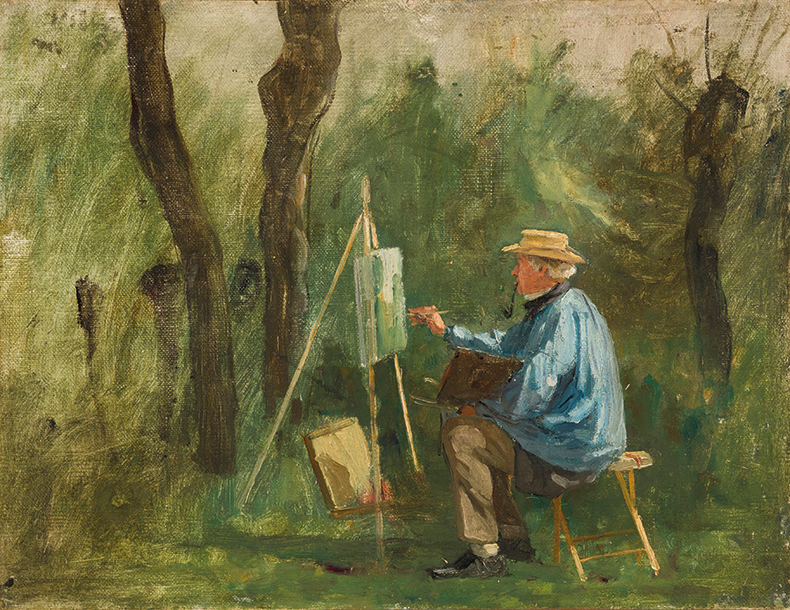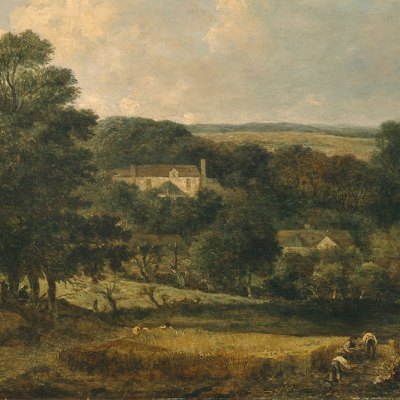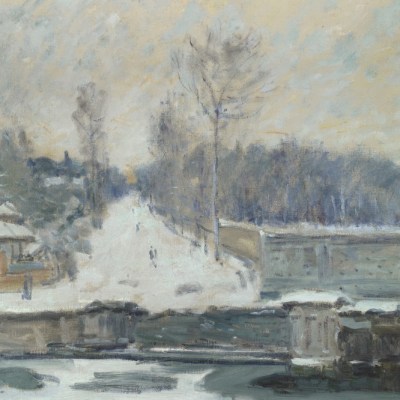Beneath the surface of ‘True to Nature: Open-air Painting in Europe 1780–1870’ at the Fitzwilliam Museum in Cambridge runs an intriguing narrative of shifting sensibilities. Most of the works gathered here were undertaken as studies for a larger work, or as technical exercises in light or atmosphere, often dashed off in an attempt to capture a time of day or a momentary effect for use later; they weren’t especially valued by the artists themselves or, until recent decades, by scholars and collectors. For modern audiences, though, the appeal of spontaneity and immediacy seem obvious (I’m sure I wasn’t the only visitor to the Royal Academy’s ‘Late Constable’ show a few months back who thought that the cloud studies and preparatory sketches showed up a staginess in the finished canvases). It is baffling that so much charm and beauty can have been overlooked for so long.
The show contains more than 100 oil sketches – from the National Gallery of Art in Washington, D.C. and the Fondation Custodia in Paris as well as from the Fitzwilliam’s own collection – on paper, canvas, paper glued to canvas and board. The exhibition opens with a portrait of Jean-Baptiste-Camille Corot: a painting by his pupil Eugène Decan from 1873, when Corot was 77, of the artist in straw hat and blue smock, pipe jutting downward from his mouth, perched on a stool before his easel, brush in right hand, paint box in left. Corot’s paint box – the same one? – is also on display. Perhaps the most entrancing object in the show, its lid is filled with small paintings glued on by the artist. Alongside these are texts, photographs, a cartoon and other objects to give some idea of how landscape painting worked in this period and how it was regarded.
Corot at his Easel, Crécy-en-Brie (1874), Eugène Decan. Courtesy Fitzwilliam Museum, Cambridge

After this, the paintings are divided thematically – there’s no attempt at chronological order, and indeed it’s hard to detect any kind of linear development that might justify that. Instead, what you see are the same struggles repeated over and over, artists fighting preconceptions and their own imaginations, trying to encounter the world as directly as possible. The most exciting works are the ones in which you can see, or imagine you see, that liberation happening, sometimes in a touch – the lightning zigzag of road down the mountainside in Simon Denis’s View of Tivoli at Night – and sometimes in a world of colour, as in the Stygian, Pollock-ish mess of Giuseppe De Nittis’s Eruption of Vesuvius (1872), which sits amid a roomful of volcanoes.
Sometimes freedom seems elusive, particularly for Scandinavian and German painters, as in Christoffer Wilhelm Eckersberg’s uninvitingly pin-sharp View of the Cloaca Maxima, Rome (1814). I wondered whether I was projecting stereotypes on to them, but Michael Clarke, in the opening essay for the catalogue, quotes the Dresden painter Adrian Ludwig Richter (1803–84), who contrasted the French love of paint with the German love of drawing: ‘We fell lovingly on each blade of grass, every twig, and we did not wish to allow any expressive details to escape.’ By contrast, Georges Michel’s View of Paris seen from Meudon is engaging partly because menacing skies blot out all the detail, so that you’re left wondering if it’s really a view of Paris at all.
The Thames at Chelsea, Evening (1853), William Holman Hunt. Courtesy Fitzwilliam Museum, Cambridge

There’s pleasure in encountering unfamiliar artists, like Pierre-Henri de Valenciennes (1750–1819), whose treatise on painting is presented as one of the great influences on outdoor painting practice, but whose Study of Clouds over the Roman Campagna (1782/85) shows that he could walk the walk, or like Max Hauschild (1810–95), represented by his dreamlike oil painting Vines seen through a Window. It’s exciting, too, to see the big names doing unexpected things: the earliest artist here is Jean-Honoré Fragonard, whose darkly swirling Mountain Landscape at Sunset (c. 1765) is hard to reconcile with The Swing (1767). There’s a night-time view of the Thames by Holman Hunt, which suggests Whistler was 20 years behind the times, and Constable’s gorgeous View of Gardens at Hampstead with an Elder Tree (c. 1821–22). You can also see big names doing what you’d expect – a couple of those Constable cloud studies, some woodland scenes (with somewhat artificial gypsies) by Turner, and the astonishing play of light on stone and water in Corot’s The Island and Bridge of San Bartolommeo, Rome (1825/28). But there are also duds: biscuit-tin Alpine scenes, lurid prog rock sunsets. The last room takes you into the concurrent ‘Hockney’s Eye’ exhibition, where Monet and Pissarro show you where it was all leading, and Hockney’s multiple-perspective video of Woldgate Woods in snow offers a tantalising reminder of the beauties of cool weather.
The Fitzwilliam has added a few local touches: labels next to paintings offer comments from academics in different university departments (botanists, ornithologists) on thoughts prompted by the works; among the volcano paintings is a cabinet full of volcanic rock samples, and one wall of the room is occupied by The Living Earth, a video by the Cambridge vulcanologist Clive Oppenheimer, who has worked with Werner Herzog. The images of rocks and water in turmoil run the risk of making mere paper and pigment look too small to contain a world so fluid and so violent. Sensibilities shift, but we can still be caught unawares by the sublime.
‘True to Nature: Open-air Painting in Europe 1780–1870’ is at the Fitzwilliam Museum, Cambridge until 29 August.



